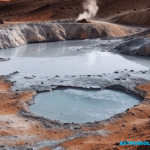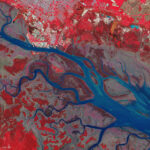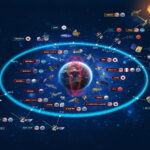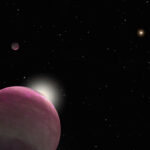Now Reading: China set for first orbital launch and landing attempt this weekend with commercial Zhuque-3 rocket
-
01
China set for first orbital launch and landing attempt this weekend with commercial Zhuque-3 rocket
China set for first orbital launch and landing attempt this weekend with commercial Zhuque-3 rocket


HELSINKI — Chinese commercial launch firm Landspace is preparing to attempt the country’s first orbital launch and booster landing this weekend with its Zhuque-3 rocket.
Airspace closure notices issued under the Civil Aviation Administration of China (CAAC) indicate a launch attempt from the vicinity of Jiuquan Satellite Launch Center between around 11:00 p.m. Eastern Nov. 28 and 1:00 a.m. Nov. 29 (0400-0600 UTC, or 12:00-2:00 p.m. Beijing time Nov. 29). A drop zone for the launch matches coordinates for a downrange landing site roughly 390 kilometers to the southeast of Jiuquan, in Minqin county, Gansu province.
The launch of Zhuque-3 will mark China’s first attempt to recover a first stage following an orbital launch, even as state-owned CASC prepares for its own attempt from Jiuquan with its Long March 12A reusable rocket.
Landspace’s Zhuque-3 is a two-stage, stainless steel rocket with a diameter of 4.5 meters and a mass at liftoff of about 570 metric tons. The rocket stands approximately 66 meters tall on the pad, with its first stage powered by nine Tianque-12A methane-liquid oxygen engines.
The launch will take place at Landspace facilities within the Dongfeng Commercial Space Innovation Test Zone near Jiuquan spaceport. Landspace had conducted a full-scale propellant loading rehearsal of the Zhuque-3 and static fire test at launch pad 2 for methane-liquid oxygen rockets Oct. 18-20.
Zhuque-3 is expected to carry a prototype of the reusable Haolong cargo spacecraft as part of a program for low-cost cargo delivery to the Tiangong space station.
The attempt comes a decade after SpaceX demonstrated a world first successful first stage rocket landing from an orbital launch using its Falcon 9 rocket. It also follows weeks after Blue Origin landed a New Glenn booster on the rocket’s second flight.
Zhuque-3 has payload capacity to low Earth orbit (LEO) of 21,000 kilograms when expendable, or up to 18,300 kg when the first stage is recovered downrange, making it comparable to the Falcon 9 in terms of payload capacity, and close behind China’s current most capable launcher—the expendable Long March 5—in. Landspace conducted a successful, 10-kilometer-altitude launch and landing test with a first stage in September last year.
Landspace posted a view from the Zhuque-3 on the pad at Jiuquan on its account on social media platform X Nov. 25, showing the distant Long March 2F rocket which launched the uncrewed Shenzhou-22 spacecraft to the Tiangong space station.
The launch of Zhuque-3 had apparently been put on hold by the imminent launch of the crewed Shenzhou-21 mission from Jiuquan in late October and the subsequent return of the Shenzhou-20 crew in early November.
The latter operation was delayed, however, by the discovery of damage to the Shenzhou-20 spacecraft by a suspected debris impact. This necessitated the use of the Shenzhou-21 spacecraft by the returning Shenzhou-20 crew, and the need for an emergency launch of Shenzhou-22, which also appears to have postponed the launch of Zhuque-3.
Zhuque-3—along with a number of rockets of other commercial and state actors also close to debut flights—is designed to be able to carry multiple satellites into orbit for China’s megaconstellations, including Guowang, Thousand Sails (Qianfan) and Honghu-3. The new rockets could provide new launch capacity in terms of payload and, eventually, a reliable high cadence of launches.
Landspace emerged soon after China opened its space sector to private capital in late 2014. The company made its first orbital launch attempt back in October 2018 with the solid propellant Zhuque-1, named after the Vermillion Bird from Chinese mythology. That launch failed, but the company had already moved on to plans to develop a methane-powered rocket, the Zhuque-2. That rocket became the first methane-fueled rocket to reach orbit in July 2023, bouncing back from a failed first attempt in December 2022. An upgraded version, the Zhuque-2E, has been flying successfully, but suffered a failure on its most recent outing Aug. 15.
The company received $123 million from China’s National Manufacturing Transformation and Upgrading Fund for its rocket plans in December 2024. Landspace filed preliminary documents with Chinese regulators in late July, potentially eyeing an initial public offering (IPO) in early 2026.
China’s early launch companies started off developing small, solid propellant rockets, mainly targeting contracts to launch cubesats for institutions. China’s commercial launch sector has since transformed, in large part due to China’s government approving and backing megaconstellation projects which call for large, reusable rockets in order to make their construction feasible, while also underlining commercial space as a national priority.
Stay Informed With the Latest & Most Important News
Previous Post
Next Post
-
 01From Polymerization-Enabled Folding and Assembly to Chemical Evolution: Key Processes for Emergence of Functional Polymers in the Origin of Life
01From Polymerization-Enabled Folding and Assembly to Chemical Evolution: Key Processes for Emergence of Functional Polymers in the Origin of Life -
 02Two Black Holes Observed Circling Each Other for the First Time
02Two Black Holes Observed Circling Each Other for the First Time -
 03How New NASA, India Earth Satellite NISAR Will See Earth
03How New NASA, India Earth Satellite NISAR Will See Earth -
 04Thermodynamic Constraints On The Citric Acid Cycle And Related Reactions In Ocean World Interiors
04Thermodynamic Constraints On The Citric Acid Cycle And Related Reactions In Ocean World Interiors -
 05Φsat-2 begins science phase for AI Earth images
05Φsat-2 begins science phase for AI Earth images -
 06Hurricane forecasters are losing 3 key satellites ahead of peak storm season − a meteorologist explains why it matters
06Hurricane forecasters are losing 3 key satellites ahead of peak storm season − a meteorologist explains why it matters -
 07Binary star systems are complex astronomical objects − a new AI approach could pin down their properties quickly
07Binary star systems are complex astronomical objects − a new AI approach could pin down their properties quickly




















